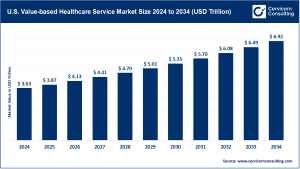Market Overview
The global artificial intelligence in pharmacovigilance market was valued at around USD 600 million in 2024 and is expected to reach approximately USD 1,992 million by 2034, growing at a CAGR of 21.5% between 2025 and 2034. This market is centered on leveraging AI technologies—including machine learning (ML), natural language processing (NLP), and robotic process automation (RPA)—to improve drug safety monitoring, streamline adverse event reporting, and optimize pharmacovigilance workflows. By automating complex and repetitive processes, AI is transforming traditional pharmacovigilance, enabling faster and more precise detection of safety signals while ensuring compliance with global regulatory standards.
Key Market Trends
-
Advanced NLP and Machine Learning Integration
AI platforms are increasingly using NLP and ML to process unstructured healthcare data from sources like electronic health records, clinical trial documentation, and social media. These systems can now identify potential adverse drug reactions (ADRs) in real time, enhancing both accuracy and operational efficiency. -
Cloud-Based Pharmacovigilance Platforms
The adoption of cloud solutions allows pharmaceutical companies and contract research organizations (CROs) to centralize pharmacovigilance data and collaborate across regions. Cloud-based platforms improve scalability, enable real-time reporting, and facilitate integration with regulatory systems, reducing operational costs. -
Regulatory Endorsement and AI Guidelines
Regulatory bodies, including the FDA and EMA, are actively supporting AI adoption in pharmacovigilance through guidance frameworks and pilot programs. Such regulatory encouragement fosters market confidence and accelerates AI integration into drug safety processes. -
Automation of Case Processing and Signal Detection
Routine and time-consuming tasks such as case triaging, coding, and reporting are increasingly automated. This trend reduces human error, speeds up adverse event reporting, and allows pharmacovigilance professionals to focus on strategic risk analysis. -
Integration with Real-World Evidence (RWE)
The use of real-world data (RWD) from wearables, patient registries, and mobile health applications is expanding. AI-driven analysis of RWD helps uncover hidden safety signals and improves post-market surveillance accuracy.
Get a Free Sample: Cervicorn Consulting
Market Drivers
-
Rising Volume of Adverse Event Reports
The growing number of clinical trials and post-market studies has significantly increased adverse event reporting. AI solutions are essential to efficiently manage large datasets, reduce processing times, and improve signal detection accuracy. -
Stringent Regulatory Requirements
Agencies like the FDA, EMA, and WHO mandate continuous monitoring and timely reporting of adverse events. AI-based pharmacovigilance tools help companies maintain compliance while minimizing regulatory risks. -
Technological Advancements
Innovations in AI algorithms, predictive modeling, and big data analytics enable proactive safety risk management, early signal detection, and improved operational efficiency. -
Adoption by Pharma and Biotech Firms
Companies are increasingly integrating AI into their pharmacovigilance processes to reduce costs, enhance efficiency, and gain a competitive advantage. AI optimizes resource allocation while ensuring regulatory compliance. -
Government Initiatives and Collaborative Research
Funding and partnerships by governments and research institutions, particularly in North America and Europe, are driving AI adoption and innovation in pharmacovigilance.
Impact of Trends and Drivers
The integration of AI technologies, cloud infrastructure, and regulatory support is reshaping pharmacovigilance workflows. Large pharmaceutical companies and CROs leverage AI for automated case processing and predictive risk management, whereas smaller biotech firms adopt cloud-based AI platforms for scalable solutions. North America leads the market due to substantial R&D investment and early AI adoption, while Asia-Pacific is emerging as a high-growth region supported by digital health initiatives and expanding pharmaceutical manufacturing.
Challenges & Opportunities
Challenges:
-
Uncertainties in AI regulation and data privacy concerns.
-
High implementation costs, especially for smaller firms.
-
Integration difficulties with legacy pharmacovigilance systems.
Opportunities:
-
Development of explainable AI (XAI) for transparent and auditable safety analysis.
-
Combining AI with blockchain for secure, tamper-proof data management.
-
Growing applications in personalized medicine and precision drug safety.
Future Outlook
The AI in pharmacovigilance market is poised for rapid growth, projected to expand at a CAGR of 21.5% through 2034. Emerging technologies such as predictive analytics, real-world data integration, and cloud-enabled AI platforms will continue to redefine drug safety operations. By transitioning from reactive monitoring to proactive risk prediction, AI will enhance operational efficiency, regulatory compliance, and patient safety, cementing its role as a critical tool in modern pharmaceutical management.
For a detailed market overview or company-specific insights, contact: Cervicorn Consulting

